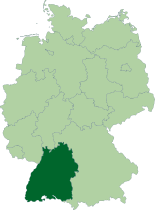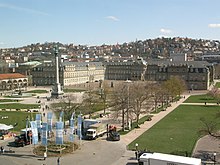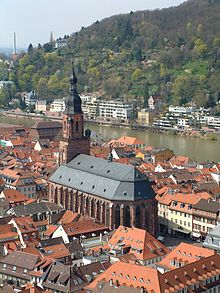Baden-Württemberg
Baden-Württemberg | |
|---|---|
 | |
| Coordinates: 48°32′16″N 9°2′28″E / 48.53778°N 9.04111°E | |
| Kintra | Germany |
| Caipital | Stuttgart |
| Govrenment | |
| • Meenister-Preses | (Greens) |
| • Govrening pairties | Greens / SPD |
| • Bundesrat votes | 6 (o 69) |
| Area | |
| • Tot | 35751.65 km2 (13,803.79 sq mi) |
| Population (2021-12-31)[1] | |
| • Tot | 11,124,642 |
| • Density | 310/km2 (810/sq mi) |
| Time zone | UTC+1 (CET) |
| • Summer (DST) | UTC+2 (CEST) |
| ISO 3166 code | DE-BW |
| GDP/ Nominal | €331 billion (2005) [citation needit] |
| NUTS Region | DE1 |
| Website | www.baden-wuerttemberg.de |
Baden-Württemberg (German pronunciation: [ˈbaːdən ˈvʏɐ̯təmˌbɛɐ̯k]) is ane o the 16 states o Germany. Baden-Württemberg is in the soothwastren pairt o the kintra tae the east o the Upper Rhine, an is the third lairgest in baith aurie an population o Germany's saxteen states, wi an aurie o 35,742 square kilometres (13,800 sq mi) an 10.7 million indwallers.[3] The state caipital is Stuttgart.
The sobriquet Ländle (dialect form for "sma land") is whiles uised as a synonym for the Swabian pairt o Baden-Württemberg.
History[eedit | eedit soorce]
The aurie uised tae be covered bi the historical states o Baden, includin the umwhile Prussian Hohenzollern, an Württemberg, pairt o the region o Swabie.[4]
Württemberg wis occupee'd bi the Romans in the first century AD who defendit thair poseetion thare bi constructin a (limes) rampart. Early on in the third century, the Alemanni drove the Romans ayont the Rhine an the Danube, but in thair turn thay succumbed tae the Franks unner Clovis I, the decisive battle takin place in 496. It later acome pairt o the Holy Roman Empire.
Efter Warld War II, Allied forces established three federal states: Württemberg-Hohenzollern, Baden (baith occupee'd bi Fraunce), an Württemberg-Baden (US-occupee'd). In 1949, thir three states became foondin members o the Federal Republic o Germany. Airticle 118 o the new German constitution, housomeivver, haed awready prepared a procedure for those states tae merge. Efter a referendum held on December 16, 1951, Württemberg-Baden, Württemberg-Hohenzollern an Baden votit in favour o a merger.[3] Baden-Württemberg offeecially became a state on Aprile 25, 1952.[3]
Geography[eedit | eedit soorce]
Baden-Württemberg shares its borders wi Fraunce, Swisserland, Rhineland-Palatinate, Hesse an Bavarie.[3]
Maist o the major ceeties o Baden-Württemberg straddle the banks o the Neckar River, which runs dounstream (frae soothwast tae the centre, then northwast) throu the state first past Tübingen, then Stuttgart, Heilbronn, Heidelberg, an Mannheim).
The Rhine (German: Rhein) forms the wastren mairch as well as lairge portions o the soothren border. The Black Forest (Schwarzwald), the main muntain range o the state, rises east o the Rhine valley. The heich plateau o the Swabian Alb, atween the Neckar, the Black Forest an the Danube, is an important European watershed. Baden-Württemberg shares Lake Constance (Bodensee; the mairch wi Swisserland is the middle o the lake) wi Swisserland an it shares the fuithills o the Alps (kent as the Allgäu) wi Bavarie an the Austrian Vorarlberg (but Baden-Württemberg daes no mairch Austrick ower land).
The Danube (Donau) river haes its soorce in Baden-Württemberg near the toun o Donaueschingen, in a place cried Furtwangen in the Black Forest.
Government[eedit | eedit soorce]
Admeenistration[eedit | eedit soorce]







Baden-Württemberg is dividit intae 35 destricts (Landkreise) an 9 independent ceeties (Stadtkreise), baith grouped intae the fower Admeenistrative Destricts (Regierungsbezirke) o Freiburg, Karlsruhe, Stuttgart, an Tübingen.
Furthermair thare are nine independent ceeties, which dae no belang tae ony destrict:
A. Baden-Baden
B. Freiburg
C. Heidelberg
D. Heilbronn
E. Karlsruhe
F. Mannheim
G. Pforzheim
H. Stuttgart
I. Ulm
Politics[eedit | eedit soorce]
The politics o Baden-Württemberg hae tradeetionally been dominatit bi the conservative Christian Democratic Union o Germany (CDU), who till 2011 haed led aw but ane govrenment syne the establishment o the state in 1952. In the state assembly elections held on 27 Mairch 2011 voters replaced the Christian Democrats an centre-richt Free Democrats coalition bi a Greens-led alliance wi the Social Democrats which secured a fower seat majority in the state parliament. Till 2001 the anti-immigration The Republicans pairty an aa haed seats in the state assembly. The Baden-Württemberg General Auditin Office acts as an independent body tae monitor the correct uise o public funds bi public offices.[5]
Economy[eedit | eedit soorce]
Awtho Baden-Württemberg is lackin naitural resoorces,[3] the state is amang the maist prosperous states in Germany[4] an is ane o the walthiest regions in Europe wi a tradeetionally law unemployment rate. A nummer o well-kent enterprises are heidquartered in the state, for example Daimler AG, Porsche, Robert Bosch GmbH (automobile industry), Carl Zeiss AG (optics), an SAP AG (lairgest software enterprise in Europe). In spite o this, Baden-Württemberg's economy is dominatit bi sma an medium-sized enterprises. Awtho poor in wirkable naitural resoorces (umwhile lead, zinc, iron, siller, copper an salts) an still rural in mony auries, the region is hivily industrialized. In 2003, thare wur amaist 8,800 manufacturin enterprises wi mair nor 20 employees, but anerlie 384 wi mair nor 500. The latter category accoonts for 43% o the 1.2 million bodies employed in industry. The Mittelstand or mid-sized company is the backbone o the Baden-Württemberg economy.[6] Medium-sized businesses an a tradeetion o branchin oot intae different industrial sectors hae ensured specialization ower a wide range. A fift o the "auld" Federal Republic's industrial gross value addit is generatit bi Baden-Württemberg. Turnower for manufacturin in 2003 exceedit 240,000 million, 43% o which came frae exports. The region depends tae some extent on global economic developments, tho the great adaptability o the region's economy haes generally helped it throu crises. Hauf o the employees in the manufacturing industry are in mechanical an electrical ingineerin an automobile construction. This is an aa whaur the lairgest enterprises are tae be foond. The importance o the precision mechanics industry an aa extends ayont the region's borders, as daes that o the optical, clock makin, toy, metallurgy an electronics industries. The textile industry, which umwhile dominatit hintle o the region, haes nou aw but disappeared frae Baden-Württemberg. Research an development (R&D) is fundit jointly bi the State an industry. In 2001, mair nor a fift o the 100,000 or sae bodies wirkin in R&D in Germany wur locatit in Baden-Württemberg, maist o them in the Stuttgart aurie.[7] Baden-Württemberg is an aa ane o the Fower Motors for Europe.
A study performed in 2007 bi the pr campaign "Initiative for New Social Market Economy" (German: Initiative Neue Soziale Marktwirtschaft (INSM)) an the tred newspaper "Wirtschaftswoche" awardit Baden-Württemberg for bein the "economically maist successful an maist dynamic state" amang the 16 states.
Tourism[eedit | eedit soorce]
Baden-Württemberg is a popular holiday destination, rivaled in Germany anerlie bi Bavarie in terms o its naitural landscapes an variety o culinary an cultural afferin an its possibilities for ootdoor activities.[4] Main sichts include the caipital an biggest ceety, Stuttgart, modren an historic at the same time, wi its urban airchitectur an atmosphere (an famously, its inner ceety pairks an historic Wilhelma zoo), its castles (sic as Castle Solitude), its (caur an airt) museums as well as a rich cultural programme (theatre, opera) an mineral spring baths in Stuttgart-Bad Cannstatt (an aa the steid o a Roman Castra), the residential (court) touns o Ludwigsburg an Karlsruhe, the spas an casino o luxurious Baden-Baden, the medieval airchitectur o Ulm (Ulm Münster is the tawest kirk in the warld), the vibrant, young, but traditional varsity touns o Heidelberg an Tübingen wi thair auld castles leukin oot abuin the river Neckar, sites o umwhile monasteries sic as the anes on Reichenau Island an at Maulbronn (baith Warld Heritage Steids) as well as Bebenhausen Abbey, the lush Upper Neckar valley (whaur Rottweil is famous for its carnival (Fastnacht)) an the pristine Danube valley, rich auld Free Imperial Ceeties sic as Biberach, Esslingen am Neckar, Heilbronn, Ravensburg, Reutlingen an Schwäbisch Hall, an the soothmaist an sunniest ceety o Germany, Freiburg, close tae Alsace an Swisserland, bein an ideal base for explorin the heights o the nearbi Black Forest (e.g. for skiin in winter or for hikin in simmer) wi its traditional veelages an the surroondin wine kintra o the Rhine Valley o Sooth Baden.[4] The kintraside o the Swabian Alb (wi Hohenzollern Castle), the lairgely pristine Swabian Forest, the Rhine Valley an Lake Constance (German: Bodensee), whaur aw kynds o watter sports are popular, wi the umwhile Imperial, the day mairch toun o Konstanz (whaur the Cooncil o Constance teuk place), the Neolithic an Bronze Age veelage at Unteruhldingen, the flouer island o Mainau, an the hametoun o the Zeppelin, Friedrichshafen a.o., are especially popular for outdoor activities in the simmer months.[4]
In ware an hairst (Aprile/Mey an September/October), beer festivals (fun fairs) are takin place at the Cannstatter Wasen in Stuttgart; the ane in the hairst, the Cannstatter Volksfest, is the seicont biggest sic festival in the warld efter the Munich Oktoberfest. In late November/early December, Christmas mercats are a tourist magnet in aw major touns, wi the biggest ane in Stuttgart, lastin for the three weeks prior tae Christmas.
The Bertha Benz Memorial Route is a 194 km signposted scenic route frae Mannheim via Heidelberg an Wiesloch tae Pforzheim an back, which follaes the route o the warld's first lang-distance journey bi automobile which Bertha Benz unnerteuk in August 1888.
Companies awned bi Baden-Württemberg[eedit | eedit soorce]
| Company | Industry | Percentage awned | Source |
|---|---|---|---|
| EnBW | Energy industry | 45% | [8] |
Education[eedit | eedit soorce]
Baden-Württemberg is hame tae some o the auldest, maist renouned an prestigious varsities in Germany, sic as the varsities o Heidelberg, Freiburg an Tübingen. It an aa contains fower o the nine German 'excellence varsities' (Heidelberg, Freiburg, Karlsruhe, an Konstanz).
Ither varsity towns are Mannheim an Ulm. Furthermore, twa varsities are locatit in the state caipital Stuttgart, the Varsity o Hohenheim an the Varsity o Stuttgart. Ludwigsburg is home tae the renowned naitional film schuil Filmakademie Baden-Württemberg (Film Academy Baden-Wuerttemberg). The private International University in Germany is situated in Bruchsal. Thare is anither private varsity, locatit in Friedrichshafen, Zeppelin Varsity.
Furthermore, thare are mair nor a dozen Fachhochschulen, i.e. varsities of applee'd sciences, as well as Pädagogische Hochschulen, i.e. teacher training colleges, an ither institutions of tertiary eddication in Baden-Württemberg (a.o. in Aalen, Esslingen, Ludwigsburg, Nürtingen, Pforzheim, Ravensburg-Weingarten, Reutlingen, several in Stuttgart, Schwäbisch Hall).
The state haes the heichest density o academic institutions o ony territorial state (i.e. excludin Berlin an Hamburg) in Germany.
Dialects[eedit | eedit soorce]
Twa dialect groups o German are spoken in Baden-Württemberg in various variants: Alemannic an Franconian dialects. In central an soothren Württemberg, the Alemannic dialect o Swabian is spoken (slichtly differin even athin the aurie, e.g. atween Upper Swabie, the Swabian Alb an the central Neckar Valley o the Stuttgart region). In Sooth Baden, the local dialects are Law Alemannic an Heich Alemannic (i.e. variants o wha is an aa Swiss German). In the northren pairt o Baden, i.e. the umwhile Kurpfalz (Electoral Palatinate) wi the caipital Heidelberg, the idiom is Rhine Franconian (i.e. Palatinate German), while in the Northeast East Franconian is spoken.
The same or seemilar Alemannic dialects are an aa spoken in the neighbourin regions, especially in Bavarian Swabie, Alsace (Alsatian), German-speakin Swisserland (Swiss German) an the Austrian Vorarlberg, while the ither Franconian dialects range frae the Netherlands ower the Rhineland, Lorraine an Hesse up tae northren Bavarie Franconie.
Demographics[eedit | eedit soorce]
The population o Baden-Württemberg is 10,749,755 (2008), o which 5,466,966 are female an 5,282,789 are male, tot population up 0.10 per cent ower a year earlier. This wis due tae mair births than daiths. In 2006, the birth rate wis 8.61 per 1000, lawer than that of 8.80 per 1000 in 2005. The daith rate decreased frae 8.80 per 1000 in 2005 tae 8.60 per 1000 in 2006. In 2008, nearly 14.87 percent o the population unner the age o 15, fell frae 15.13 per cent ower a previous year. The proportion o fowk aged 65 an ower rose frae 18.72 per cent tae 18.99 per cent. Correspondingly, the median age (aged 15–64) o the population fell frae 66.15 tae 66.14 ower the same period. The ratio o fowk aged unner 15 an aged 65 an ower tae the population o wirkin age (aged 15–64), the owerall dependency ratio is 512 per 1000 in 2008. The sex ratio o tot population is 0.966 male(s)/female.
Releegion[eedit | eedit soorce]
While Northren an maist o central Württemberg haes been tradeetionally Lutheran–Protestant (later an aa Pietist) syne the Reformation that wis adoptit thare in 1534 (wi its centre at the famous Tübinger Stift) an the umwhile Electoral Palatinate (Northwastren Baden) wi its caipital Heidelberg wis shaped bi Calvinism afore bein integratit intae Baden, Upper Swabie, the Upper Neckar Valley up tae the bishop seat o Rottenburg an Soothren Baden (the Catholic airchbishopric haes its see in Freiburg) hae tradeetionally been bastions o Catholicism.
| Releegion | % | |
|---|---|---|
| Roman Catholics | 36.9%[9] | 4.0M |
| Evangelical Kirk in Germany | 33.3%[10] | 3.6M |
| Muslims | 5.6% | 600 000 |
| Buddhists | 0.23% | 25 000 |
| Hindu | 0.14% | 15 000 |
| Jews | 0.08% | 9 000 |
| Non Releegious | 22.3% | 2.4M |
Islamic heidscarf controversy[eedit | eedit soorce]
Baden-Württemberg wis the first o Germany's 16 states tae ootlaw the wearin o heidscarves bi Muslim teachers at state schuils efter a seemilar ban in Fraunce in 2004. Several resultant cases received internaitional attention.
In ane prominent example, ane o the weemen affectit, Doris Graber, haed been teachin syne 1973 but began wearin a heidscarf in 1995. On 18 Mairch 2008, a German court ruled that she coud no wear a heidscarf despite her argument that she shoud be permittit tae dae sae unner equal treatment laws syne nuns war alloued tae teach in a public schuil at that time while wearin releegious habits.[11] The state attorney spoke o a "historic exception" in the aforementioned public schuil whaur the nuns still teach in habit.[11] The schuil, a umwhile monastery, wis taken ower bi the state an authorities are bund tae a contract govrenin the "exceptions status" o the schuil.[11]
See an aa[eedit | eedit soorce]
- Baden, for the pre-19t century state
- History o Baden
- Meenister-Preses o Baden-Württemberg
- Oreegin o the coats o airms o German federal states
- Grand Duchy o Baden, for the state that existit frae 1808–1918
- Republic o Baden, for the state that existit frae 1918–1945
- Rulers o Baden, for a leet o sovereigns an preses
- Leet o places in Baden-Württemberg
- Fower Motors for Europe
Footnotes[eedit | eedit soorce]
- ↑ "Bevölkerung nach Nationalität und Geschlecht am 31. Dezember 2021" [Population bi naitionality an sex as o 31 December 2021] (CSV) (in German). Statistisches Landesamt Baden-Württemberg. Juin 2022.
- ↑ "State population". Portal of the Federal Statistics Office Germany. Archived frae the original on 5 December 2010. Retrieved 25 Apryle 2007.
- ↑ a b c d e "Our State". Baden-Württemberg. Archived frae the original on 3 Julie 2007. Retrieved 30 Mairch 2011.
- ↑ a b c d e Andrea Schulte-Peevers (2007). Germany. Lonely Planet. ISBN 9781740599887. Retrieved 1 Februar 2009. Unknown parameter
|coauthors=ignored (|author=suggested) (help) - ↑ "Government and organs of state". Baden-Württemberg. Archived frae the original on 8 Februar 2006. Retrieved 30 Mairch 2011.
- ↑ Cooke, p. 84
- ↑ "BADEN - WÜRTTEMBERG - Economy". Eurostat. Juin 2004. Archived frae the original on 23 December 2008. Retrieved 16 Januar 2009.
- ↑ Haase, Nina (30 Mairch 2011). "Business leaders wary of Greens' state election victory". Deutsche Welle. Retrieved 30 Mairch 2011.
- ↑ chiesa cattolica http://www.dbk.de/imperia/md/content/kirchlichestatistik/bev-kath-l__nd-2008.pdf[deid airtin]
- ↑ EKD http://www.ekd.de/download/kirchenmitglieder_2007.pdf
- ↑ a b c "German Court Upholds School Ban on Muslim Headscarf". Deutsche Welle. 18 Mairch 2008. Retrieved 14 Januar 2009.
References[eedit | eedit soorce]
- Philip Cooke, Kevin Morgan (1998). The Associational Economy: Firms, Regions, and Innovation. Oxford University Press. p. 84. ISBN 9780198296591.
Freemit airtins[eedit | eedit soorce]
| Wikimedia Commons haes media relatit tae Baden-Württemberg. |
| Wikimedia Commons haes media relatit tae Baden-Württemberg. |




